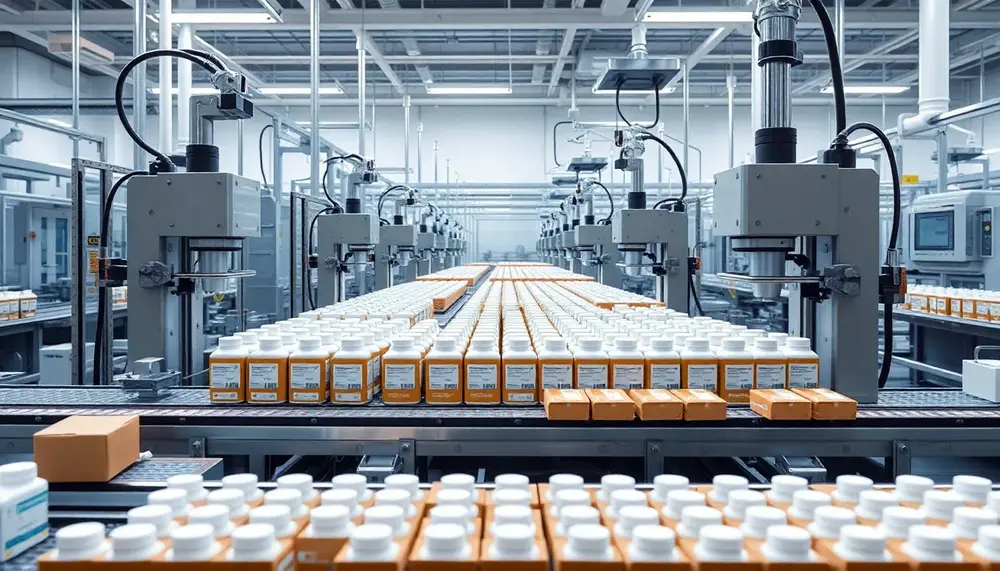Table of Contents:
Understanding Pharmaceutical Packaging Systems
Pharmaceutical packaging systems are like the unsung heroes in the world of medicine. You might not think about them much, but they play a huge role in keeping your meds safe and sound. Imagine a world where your pills arrive crumbled or your liquid meds leak everywhere. Not fun, right? That's where these packaging systems step in, ensuring everything is neat, tidy, and ready for use.
Now, let's break it down a bit. These systems are not just about putting pills in a bottle. Oh no, it's much more intricate. They involve a whole process that considers how the medicine is stored, how it travels, and how you, the user, will eventually get to it. It's like a carefully choreographed dance, where every step matters.
What's fascinating is how these systems have evolved. With technology marching forward, packaging isn't just about containment anymore. It's about enhancing the user experience, improving safety, and even helping with things like dosage accuracy. The materials used are chosen with precision, balancing between protection and cost-effectiveness. And yes, there’s a lot of thought put into making sure that the packaging doesn’t interact negatively with the meds inside.
So, when you pop open that blister pack or twist off the cap of a bottle, remember there's a whole world of innovation and careful planning behind it. Pharmaceutical packaging systems are not just about keeping things together; they're about making sure everything works just right, from the factory to your medicine cabinet.
How Packaging Enhances Drug Safety and Efficiency
When it comes to pharmaceuticals, safety and efficiency are like the bread and butter of the industry. Packaging plays a pivotal role in both these aspects, ensuring that drugs not only reach consumers in pristine condition but also do so efficiently. It's not just about wrapping things up; it's about creating a fortress around the medicine.
First off, let's talk safety. Packaging is the first line of defense against contamination. It keeps out moisture, air, and light, all of which can degrade the quality of the medication. Imagine leaving a loaf of bread out in the open—pretty soon, it's going to go stale. Similarly, drugs need that protective barrier to maintain their efficacy.
Then there's the efficiency angle. Efficient packaging means that drugs can be transported and stored with minimal fuss. Think about it: a well-designed package can reduce space, making it easier to ship more products at once. This not only cuts down on costs but also speeds up the delivery process. It's like packing a suitcase; the better you pack, the more you can fit in.
Moreover, packaging often includes essential information, like dosage instructions and expiration dates, which are crucial for both safety and efficiency. These details help ensure that patients use the medication correctly, avoiding any potential mishaps.
In essence, pharmaceutical packaging is like a well-oiled machine, working tirelessly to keep drugs safe and efficient. It's a blend of science and art, where every element is meticulously crafted to serve a purpose. So next time you pick up a medication, take a moment to appreciate the packaging—it’s doing a lot more than you might think.
Pros and Cons of Pharmaceutical Packaging Systems
| Aspect | Pros | Cons |
|---|---|---|
| Safety | Prevents contamination, maintains drug efficacy, and ensures child safety with secure packaging. | Complex packaging designs may be challenging for elderly or disabled users to open. |
| Efficiency | Optimized packaging reduces shipping costs and increases storage capacity. Automated processes enhance production speed. | Initial investment in advanced technology and systems can be high. |
| Sustainability | Use of biodegradable materials reduces environmental impact. Efficient logistics reduce carbon footprint. | Transition to sustainable materials may increase packaging costs initially. |
| Information | Packaging includes important details such as dosage instructions and expiration dates, aiding proper medication usage. | Misleading or unclear labeling can result in misuse or noncompliance. |
The Role of Primary, Secondary, and Tertiary Packaging
In the world of pharmaceuticals, packaging isn't just a one-size-fits-all deal. It's a layered approach, with each layer playing its own unique role. Let's dive into the three main types: primary, secondary, and tertiary packaging. Each has its own job, and together, they create a seamless system that keeps medications safe and sound.
Primary packaging is the first line of defense. It's the packaging that directly touches the product. Think of it as the closest guardian to the medicine. Whether it's a blister pack for tablets or a vial for liquids, primary packaging is all about protecting the drug from external factors and ensuring it's ready for use. It’s like the inner shell of a turtle, snug and secure.
Next up, we have secondary packaging. This layer adds an extra shield and often includes branding and information. It's like the flashy outerwear that not only protects but also informs. Cartons and boxes fall into this category, providing additional cushioning and a platform for crucial details like dosage instructions and brand logos. It's the part that catches your eye on the pharmacy shelf.
Finally, there's tertiary packaging. This is the heavy-duty stuff, designed for bulk handling and transportation. It's all about logistics, ensuring that large quantities of products can be moved efficiently from one place to another without damage. Think of it as the sturdy crate that holds everything together during shipping, ensuring that products arrive in perfect condition.
Each of these packaging layers has its own role, but together, they form a comprehensive system that enhances the safety, efficiency, and accessibility of pharmaceutical products. It's a well-orchestrated symphony, where every note matters in delivering medications safely to the end user.
Innovative Materials in Pharmaceutical Packaging
When it comes to pharmaceutical packaging, the materials used are like the unsung heroes. They quietly do their job, ensuring that medicines remain safe and effective. But what's really exciting is how innovative these materials have become. It's not just about glass and plastic anymore; it's about using cutting-edge technology to create smarter, more efficient packaging solutions.
One of the game-changers in this field is the use of smart polymers. These materials can respond to environmental changes, like temperature or humidity, which is pretty neat. Imagine a package that can tell if it's getting too hot and adjust itself to protect the medicine inside. It's like having a mini climate control system built right into the packaging.
Then there's the rise of biodegradable materials. With sustainability becoming a big deal, the pharmaceutical industry is looking for ways to reduce its environmental footprint. Biodegradable packaging offers a solution, breaking down naturally without leaving harmful residues. It's a win-win for both the planet and the industry.
Another innovative material making waves is nanocomposites. These materials incorporate nanoparticles to enhance the barrier properties of packaging. This means better protection against moisture and oxygen, keeping drugs fresher for longer. It's like adding an extra layer of armor to the packaging, without adding bulk.
These innovations in materials are transforming pharmaceutical packaging, making it more efficient, sustainable, and effective. It's a testament to how far technology has come, and a glimpse into the future of packaging solutions. So, next time you pick up a medication, remember that there's a whole world of innovation wrapped around it, quietly doing its job.
Design Considerations for Optimal Packaging Efficiency
Designing pharmaceutical packaging is like solving a complex puzzle. It's not just about making something look good; it's about ensuring that the packaging is efficient, practical, and user-friendly. There are several key considerations that designers must keep in mind to achieve optimal packaging efficiency.
First and foremost, usability is crucial. Packaging should be easy to open and handle, especially for patients who might have limited dexterity. Think about those child-resistant caps that are a bit tricky for kids but manageable for adults. It's a fine balance between safety and accessibility.
Another important factor is space optimization. Efficient packaging should minimize wasted space, both in terms of storage and transportation. This means designing packages that fit snugly around the product, reducing excess material and making it easier to stack and ship. It's like playing a game of Tetris, where every piece needs to fit just right.
Then there's the consideration of regulatory compliance. Packaging must meet strict guidelines to ensure safety and efficacy. This includes everything from labeling requirements to material specifications. Designers need to be well-versed in these regulations to create packaging that not only looks good but also ticks all the legal boxes.
Lastly, cost-effectiveness is always a consideration. While it's tempting to go all out with fancy materials and designs, the packaging must remain economically viable. This means finding that sweet spot where quality meets affordability, ensuring that the packaging enhances the product without breaking the bank.
In essence, designing pharmaceutical packaging is a balancing act, where every decision impacts the overall efficiency and effectiveness of the final product. It's a blend of art and science, where creativity meets practicality to deliver packaging solutions that work seamlessly in the real world.
Ensuring Child Safety in Pharmaceutical Packaging
Child safety in pharmaceutical packaging is a top priority. It's all about creating a barrier between curious little hands and potentially harmful medications. The challenge? Making sure that while it's tough for kids to open, it's still user-friendly for adults. It's a delicate dance of design and functionality.
One of the most common solutions is the use of child-resistant closures. These are those caps that require a bit of a push-and-turn action to open. They might seem like a minor inconvenience, but they play a crucial role in preventing accidental ingestion by children. It's like having a lock on a treasure chest, keeping the contents safe from unintended access.
Beyond closures, there's also the design of the packaging itself. Blister packs are often used for tablets and capsules, providing an additional layer of protection. Each dose is sealed in its own compartment, making it harder for children to access multiple doses at once. It's a simple yet effective way to add an extra layer of security.
Additionally, clear labeling is essential. Warnings and instructions should be prominently displayed, ensuring that caregivers are aware of the potential risks and the correct way to handle the medication. It's like having a set of instructions right on the package, guiding users on safe usage.
Ultimately, ensuring child safety in pharmaceutical packaging is about foresight and innovation. It's about anticipating potential risks and designing solutions that mitigate them. It's a commitment to safety that goes beyond the product itself, extending to the packaging that holds it.
Leveraging Technology to Improve Packaging Processes
In the fast-paced world of pharmaceuticals, technology is like the secret sauce that keeps everything running smoothly. When it comes to packaging processes, leveraging technology can make a world of difference. It's about making things faster, smarter, and more efficient, all while maintaining the highest standards of safety and quality.
One of the most exciting advancements is the use of automation. Automated systems can handle everything from filling and sealing to labeling and inspecting. This not only speeds up the process but also reduces the risk of human error. Imagine a well-oiled machine that works tirelessly, ensuring each package is perfect before it leaves the production line.
Then there's the role of smart packaging. This involves integrating technology into the packaging itself, such as RFID tags or QR codes. These can provide real-time data on the product's location, condition, and even its history. It's like giving each package its own digital passport, ensuring traceability and transparency throughout the supply chain.
Moreover, advanced analytics are transforming how companies approach packaging. By analyzing data from production lines, companies can identify bottlenecks, predict maintenance needs, and optimize processes. It's like having a crystal ball that helps foresee and solve problems before they even arise.
Lastly, 3D printing is opening up new possibilities for packaging design. It allows for rapid prototyping and customization, enabling companies to experiment with new designs and materials without the need for costly molds. It's like having a magic wand that can bring innovative ideas to life in no time.
In essence, technology is revolutionizing pharmaceutical packaging processes, making them more efficient, reliable, and adaptable. It's a testament to how far we've come and a glimpse into the future of packaging innovation.
The Impact of Packaging on Supply Chain Efficiency
Packaging is like the unsung hero of the supply chain. It might not be the first thing that comes to mind when you think about logistics, but its impact is profound. Efficient packaging can streamline the entire supply chain, from manufacturing to delivery, ensuring that products reach their destination safely and on time.
One of the key ways packaging enhances supply chain efficiency is through space optimization. By designing packaging that fits products snugly, companies can maximize the use of space in storage and transportation. This means more products can be shipped in a single load, reducing costs and environmental impact. It's like playing a game of chess, where every move is calculated to make the most of available resources.
Another important aspect is durability. Packaging needs to withstand the rigors of transportation, protecting products from damage. Sturdy packaging reduces the risk of breakage and spoilage, minimizing losses and ensuring that products arrive in perfect condition. It's like having a suit of armor that shields the product from the bumps and bruises of the journey.
Moreover, traceability is a crucial factor. Packaging that incorporates tracking technology, such as barcodes or RFID tags, allows for real-time monitoring of products as they move through the supply chain. This enhances transparency and accountability, making it easier to identify and address any issues that arise. It's like having a GPS for your products, ensuring they stay on the right path.
Lastly, standardization in packaging can simplify logistics. By using standardized sizes and materials, companies can streamline processes and reduce complexity. This leads to faster handling times and more efficient operations. It's like having a universal language that everyone in the supply chain understands, facilitating smoother communication and coordination.
In conclusion, packaging plays a pivotal role in enhancing supply chain efficiency. It's the glue that holds everything together, ensuring that products move seamlessly from point A to point B. By optimizing packaging, companies can achieve significant improvements in cost, speed, and reliability, ultimately delivering better value to their customers.
Case Studies: Successful Pharmaceutical Packaging Solutions
Exploring real-world examples of successful pharmaceutical packaging solutions can offer valuable insights into how innovative approaches are making a difference. These case studies highlight how companies have tackled challenges and achieved remarkable results in packaging efficiency and safety.
One standout example is a leading pharmaceutical company that implemented smart blister packs for their medication. By integrating NFC (Near Field Communication) technology, they enabled patients to tap their smartphones on the pack to access dosage reminders and information. This not only improved patient adherence but also provided valuable data on usage patterns, enhancing both user experience and product monitoring.
Another case involves a company that revolutionized vaccine packaging for distribution in remote areas. They developed a packaging solution with advanced insulation materials that maintained the required temperature for longer periods without refrigeration. This innovation significantly reduced spoilage rates and ensured vaccines reached their destinations in optimal condition, ultimately improving public health outcomes.
In the realm of sustainability, a pharmaceutical firm adopted biodegradable packaging for their over-the-counter products. By switching to eco-friendly materials, they not only reduced their environmental footprint but also attracted environmentally conscious consumers. This move demonstrated that sustainability and efficiency can go hand in hand, offering a competitive edge in the market.
Lastly, a company faced with high transportation costs turned to customized packaging design to optimize space. By redesigning their packaging to fit more units per shipment, they achieved significant cost savings and reduced their carbon emissions. This strategic move showcased how thoughtful design can lead to substantial operational improvements.
These case studies illustrate the power of innovative packaging solutions in the pharmaceutical industry. By addressing specific challenges and leveraging technology, companies can enhance efficiency, safety, and sustainability, ultimately delivering better outcomes for both their business and their customers.
Frequently Asked Questions about Pharmaceutical Packaging Systems
What are the main types of pharmaceutical packaging?
Pharmaceutical packaging is categorized into three main types: primary, secondary, and tertiary packaging. Primary packaging directly contacts the product, secondary provides additional protection and branding, and tertiary is used for bulk handling and transportation.
Why is child-resistant packaging important in pharmaceuticals?
Child-resistant packaging is critical to prevent accidental ingestion by children. It ensures safety by requiring a specific opening procedure that is typically difficult for young children but manageable for adults.
What materials are commonly used in pharmaceutical packaging?
Common materials used in pharmaceutical packaging include glass and plastics. Glass is valued for its durability and inertness, while plastics like PET, PP, LDPE, and HDPE are versatile for various packaging needs.
How does packaging impact the efficiency of the pharmaceutical supply chain?
Efficient packaging optimizes space and durability, facilitating better storage and transportation. It enhances traceability and standardization, crucial for reducing costs and improving supply chain logistics.
What role does technology play in pharmaceutical packaging?
Technology greatly enhances pharmaceutical packaging through automation, smart packaging, and advanced analytics. These advancements increase efficiency, reduce errors, and enable real-time monitoring and data collection.






